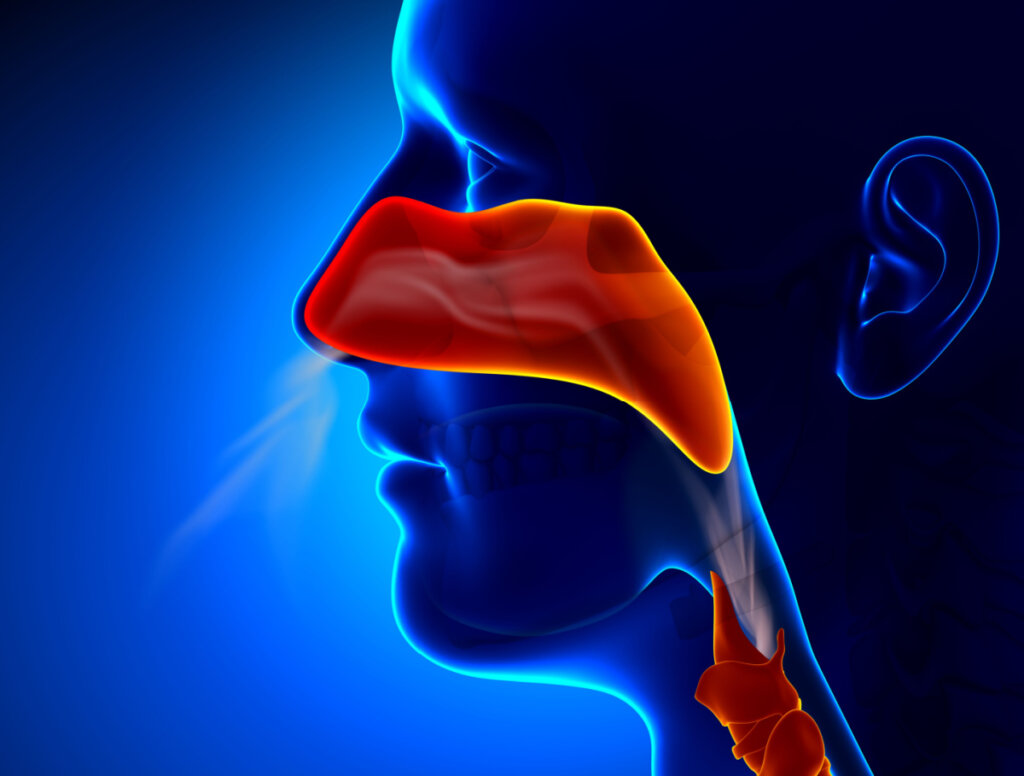Sensorineural Anosmia: Alterations in the Sense of Smell


Written and verified by the psychologist Gorka Jiménez Pajares
Imagine living in a world without odors. People with anosmia find themselves facing this extremely complex situation. In fact, our sense of smell is, like the rest of our senses, essential for our survival. Indeed, this sense alerts us to certain threats in the environment and also allows our memories to emerge.
The sense of smell is part of the chemical neurosensory system (Guerra, 2016), in which nearly fifty million neurons participate. It’s thanks to this system that we can identify different molecules and cognitively label them under the names that characterize them. For instance, “It smells like candy” or “It smells like smoke”.
“All smells, pleasant or not, are extraordinary evokers of memories.”
-Primo Levi-

The sense of smell
Imagine living in a world where people lack the ability to recognize a fire by its smell. Our sense of smell, in addition to providing us with delicious olfactory experiences, allows us to survive potentially life-threatening circumstances. Another example is smelling a certain food and coming to the conclusion that it’s rotten.
Your nose captures the molecules that certain objects give off, the so-called olfactory molecules. Then, sensory data is transmitted, from the nasal nerve endings to the olfactory bulb. In this region, lies an area known as the olfactory epithelium. Here, there are groups of thousands of cells that are responsible for emitting the message of smell to the brain.
The vehicle that allows the connection between the olfactory bulb and the brain region where the molecule is labeled (“It’s chocolate”.”It smells like cheese”. “It smells rotten”) is called the olfactory tract. This sensory vehicle leads to another structure, the cortex.
“You have taken your smell of the forest and the taste of life.”
-Antonio Gala-
Olfactory cortex anatomy
The olfactory cortex is the center that directs the orchestra of smells. Thanks to this region, you’re able to identify and recognize what you’re smelling at any given time. Moreover, it even allows you to differentiate between various aromas that you may be perceiving at the same time. It’s assisted by the following regions:
- The anterior olfactory nucleus. It makes you aware of what you’re smelling right now, in the present moment. In addition, it gives you the ability to differentiate between various types of odors. For example “It smells sweet” or “It smells like flowers.”
- The olfactory tubercle. It allows you to feel strengthened by certain fragrances. It’s thanks to this region that the smell of sweetness gives you pleasure. Unsurprisingly, you tend to get closer to the smells you like.
- The piriform cortex. This region provides support to the previous structure. Its objective is that you discriminate and label the odor molecules.
- The anterior cortical nucleus of the amygdala. It helps the emotions on which smell leaves an intense imprint. For example, if you smell smoke in the vicinity, you might feel fear. This structure modulates your entire hormonal and behavioral response. Consequently, you react to the situation and can save yourself. It’s also linked to the following structure.
- The entorhinal cortex. This structure helps you answer certain questions. For example, why do you associate a certain smell with a particular person? Why do you reject certain fragrances? In PTSD sufferers, why, when faced with certain odors present at the time of the trauma, do their post-traumatic symptoms revive and intensify? The answers lie in this structure. It stores our memories of smells.
One of the structures to which these regions project their information is the orbitofrontal cortex (OFC). If this region suffers an injury, the individual will be unable to distinguish what odor they’re perceiving.
“Patients with lesions in the orbitofrontal cortex can detect the presence or absence of an odor, but are unable to discriminate between odors.”
-Oris Lam de Calvo-
An approach to the etiology of anosmia
We can define the term anosmia as deprivation of the ability to smell. It’s total and affects the entire olfactory ability. As a result, sufferers are unable to smell anything, unlike in cases of recently exposed lesions in the orbitofrontal cortex.
In addition, people with anosmia are prone to also lose the ability to enjoy food, as it lacks flavor. This pathology is called ageusia. There are different levels or degrees of olfactory loss (Chaves-Morillo, 2017):
- Normosmia. The normal ability to smell.
- Hyposmia. Reduced ability to smell.
- Hyperosmia. Increased ability to smell.
- Dysosmia. Alteration or distortion in the perception of smell. It can occur in the context of schizophrenia.
The causes of anosmia can be found in the patient’s psychiatric history, such as deficits in short-term memory (Guerra, 2016). Neurological history is also relevant. For example, head trauma. It can also be caused by the effects of certain viral agents. For instance, the SARS-COV-2 virus.

Causes of sensorineural anosmia
For sensorineural anosmia to make an appearance in people’s lives, some or all of the previously mentioned brain structures must be inflamed or injured. In fact, there are multiple and extremely diverse paths that might lead to this complex syndrome. The following causes have been reported (Guerra, 2016):
- Trauma to the skull.
- Normal aging processes.
- Alzheimer’s type dementia.
- Obstruction of the nose caused by a virus infection.
- Brain tumor.
- Consumption of medications. For instance, the antipsychotic, reserpine.
- Surgery.
- Medical treatments for cancer.
- Smoking.
Different types
When it’s due to trauma, this condition is known as traumatic sensorineural anosmia When the causative agent is a virus, as occurs in COVID-19, it’s known as the viral type. On the other hand, when anosmia has an unknown etiology, it’s known as idiopathic. Experts have developed interventions focused on the rehabilitation of these conditions.
As a matter of fact, rehabilitation of this particular sense is key, both for the patient’s own safety and psychological well-being. Indeed, a sense of smell, in addition to giving us the ability to detect dangerous situations, allows us to remember scenes based on the smells we can perceive.
“The loss of smell has been related to the appearance of memory alterations, which represent a fundamental piece in the course of neurodegenerative diseases.”
-Virginia Chaves-Morillo-
Imagine living in a world without odors. People with anosmia find themselves facing this extremely complex situation. In fact, our sense of smell is, like the rest of our senses, essential for our survival. Indeed, this sense alerts us to certain threats in the environment and also allows our memories to emerge.
The sense of smell is part of the chemical neurosensory system (Guerra, 2016), in which nearly fifty million neurons participate. It’s thanks to this system that we can identify different molecules and cognitively label them under the names that characterize them. For instance, “It smells like candy” or “It smells like smoke”.
“All smells, pleasant or not, are extraordinary evokers of memories.”
-Primo Levi-

The sense of smell
Imagine living in a world where people lack the ability to recognize a fire by its smell. Our sense of smell, in addition to providing us with delicious olfactory experiences, allows us to survive potentially life-threatening circumstances. Another example is smelling a certain food and coming to the conclusion that it’s rotten.
Your nose captures the molecules that certain objects give off, the so-called olfactory molecules. Then, sensory data is transmitted, from the nasal nerve endings to the olfactory bulb. In this region, lies an area known as the olfactory epithelium. Here, there are groups of thousands of cells that are responsible for emitting the message of smell to the brain.
The vehicle that allows the connection between the olfactory bulb and the brain region where the molecule is labeled (“It’s chocolate”.”It smells like cheese”. “It smells rotten”) is called the olfactory tract. This sensory vehicle leads to another structure, the cortex.
“You have taken your smell of the forest and the taste of life.”
-Antonio Gala-
Olfactory cortex anatomy
The olfactory cortex is the center that directs the orchestra of smells. Thanks to this region, you’re able to identify and recognize what you’re smelling at any given time. Moreover, it even allows you to differentiate between various aromas that you may be perceiving at the same time. It’s assisted by the following regions:
- The anterior olfactory nucleus. It makes you aware of what you’re smelling right now, in the present moment. In addition, it gives you the ability to differentiate between various types of odors. For example “It smells sweet” or “It smells like flowers.”
- The olfactory tubercle. It allows you to feel strengthened by certain fragrances. It’s thanks to this region that the smell of sweetness gives you pleasure. Unsurprisingly, you tend to get closer to the smells you like.
- The piriform cortex. This region provides support to the previous structure. Its objective is that you discriminate and label the odor molecules.
- The anterior cortical nucleus of the amygdala. It helps the emotions on which smell leaves an intense imprint. For example, if you smell smoke in the vicinity, you might feel fear. This structure modulates your entire hormonal and behavioral response. Consequently, you react to the situation and can save yourself. It’s also linked to the following structure.
- The entorhinal cortex. This structure helps you answer certain questions. For example, why do you associate a certain smell with a particular person? Why do you reject certain fragrances? In PTSD sufferers, why, when faced with certain odors present at the time of the trauma, do their post-traumatic symptoms revive and intensify? The answers lie in this structure. It stores our memories of smells.
One of the structures to which these regions project their information is the orbitofrontal cortex (OFC). If this region suffers an injury, the individual will be unable to distinguish what odor they’re perceiving.
“Patients with lesions in the orbitofrontal cortex can detect the presence or absence of an odor, but are unable to discriminate between odors.”
-Oris Lam de Calvo-
An approach to the etiology of anosmia
We can define the term anosmia as deprivation of the ability to smell. It’s total and affects the entire olfactory ability. As a result, sufferers are unable to smell anything, unlike in cases of recently exposed lesions in the orbitofrontal cortex.
In addition, people with anosmia are prone to also lose the ability to enjoy food, as it lacks flavor. This pathology is called ageusia. There are different levels or degrees of olfactory loss (Chaves-Morillo, 2017):
- Normosmia. The normal ability to smell.
- Hyposmia. Reduced ability to smell.
- Hyperosmia. Increased ability to smell.
- Dysosmia. Alteration or distortion in the perception of smell. It can occur in the context of schizophrenia.
The causes of anosmia can be found in the patient’s psychiatric history, such as deficits in short-term memory (Guerra, 2016). Neurological history is also relevant. For example, head trauma. It can also be caused by the effects of certain viral agents. For instance, the SARS-COV-2 virus.

Causes of sensorineural anosmia
For sensorineural anosmia to make an appearance in people’s lives, some or all of the previously mentioned brain structures must be inflamed or injured. In fact, there are multiple and extremely diverse paths that might lead to this complex syndrome. The following causes have been reported (Guerra, 2016):
- Trauma to the skull.
- Normal aging processes.
- Alzheimer’s type dementia.
- Obstruction of the nose caused by a virus infection.
- Brain tumor.
- Consumption of medications. For instance, the antipsychotic, reserpine.
- Surgery.
- Medical treatments for cancer.
- Smoking.
Different types
When it’s due to trauma, this condition is known as traumatic sensorineural anosmia When the causative agent is a virus, as occurs in COVID-19, it’s known as the viral type. On the other hand, when anosmia has an unknown etiology, it’s known as idiopathic. Experts have developed interventions focused on the rehabilitation of these conditions.
As a matter of fact, rehabilitation of this particular sense is key, both for the patient’s own safety and psychological well-being. Indeed, a sense of smell, in addition to giving us the ability to detect dangerous situations, allows us to remember scenes based on the smells we can perceive.
“The loss of smell has been related to the appearance of memory alterations, which represent a fundamental piece in the course of neurodegenerative diseases.”
-Virginia Chaves-Morillo-
All cited sources were thoroughly reviewed by our team to ensure their quality, reliability, currency, and validity. The bibliography of this article was considered reliable and of academic or scientific accuracy.
-
Chaves-Morillo, V., Gómez-Calero, C., Fernández-Muñoz, J. J., Toledano-Muñoz, A., Fernández-Huete, J., Martínez-Monge, N., … & Peñacoba-Puente, C. (2017). La anosmia neurosensorial: relación entre subtipo, tiempo de reconocimiento y edad. Clínica y Salud, 28(3), 155-161.
- Guerra Sánchez, M., Escanero Marcén, J., Izquierdo Álvarez, S. (2016). Anosmia. SEQC Ed Cont Lab Clin, 26: 81-91
- e Calvo O (2016). Fisiología del olfato. Fernández-Tresguerres J.A., & Ruiz C, & Cachofeiro V, & Cardinali D.P., & Escriche E, & Gil-Loyzaga P.E., & Juliá V, & Teruel F, & Pardo M, & Menéndez J(Eds.), Fisiología humana, 4e. McGraw Hill. https://accessmedicina.mhmedical.com/content.aspx?bookid=1858§ionid=134364259
This text is provided for informational purposes only and does not replace consultation with a professional. If in doubt, consult your specialist.







